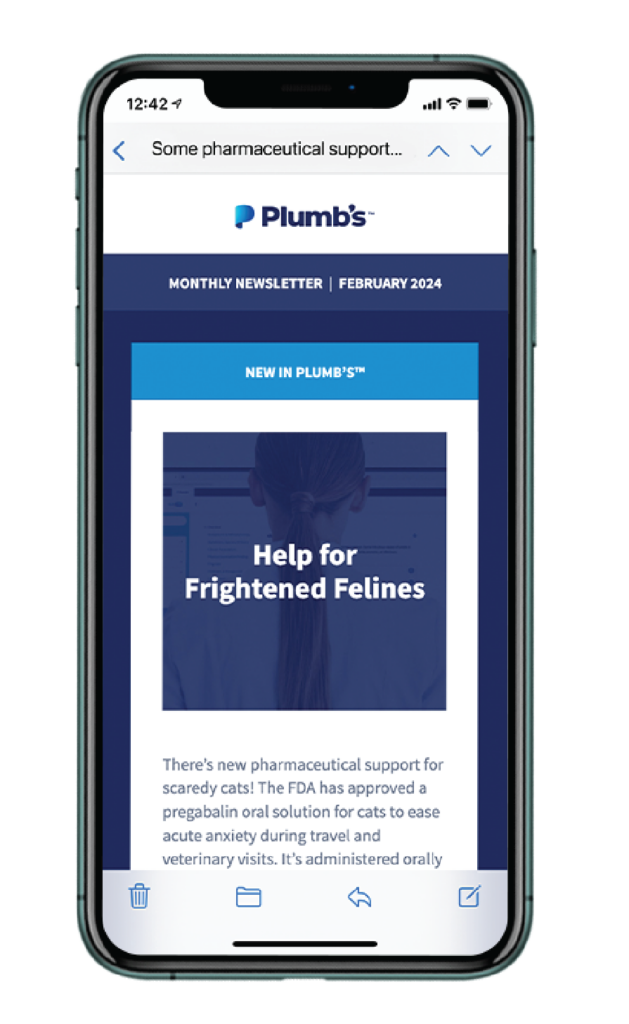How do you keep track of important information between publication dates? Even when you know the highlights, collecting all the relevant information yourself can be a pain.
When, say, a new biologic osteoarthritis medication hits the market, will you have the information you need? Or when an existing medication gets conditional FDA approvals for delaying the onset of congestive heart failure?
Plus, there are consensus statements to sift through, new research highlighting a potential side effect, and a new extra-label indication that never even crossed your desk. That’s why we continually update Plumb’s™, so the drug information you need to practice is already at your fingertips.
But what does that actually mean? What information do we include? Who writes and reviews new content? How can you tell what’s been updated?
Let’s look behind the scenes at a few common questions we get about the continual updates to Plumb’s™.
1. What’s included in updates to Plumb’s Veterinary Drugs®?
What’s most important to your patients is most important to the Plumb’s™ team. That means our primary focus is on updates that impact patient safety, like adverse effects. Then we work through changes that impact the drugs we all use and how we use them in practice—including new indications, dosage information, and dosage forms.
Under the guidance of our Editor-in-Chief, James Budde, PharmD, DICVP, we develop new drug monographs for recently approved veterinary drugs and for extra-label drugs that have a strong track record of safety in peer-reviewed clinical literature.
For new, FDA-approved veterinary drugs, we compile information from the approval paperwork, including the drug’s new animal drug application (NADA), the Freedom of Information (FOI) Summary, and any preapproval studies.
Plumb’s is more than a formulary; it’s a drug reference. That means we include and cite information according to principles of evidence-based medicine. So, when compiling updates, we prioritize comprehensive reviews of peer-reviewed research, consensus statements, and databases over conference proceedings and substantiated clinical expert opinions.
2. Who writes and updates drug information in Plumb’s™?
The continual updates in Plumb‘s are compiled and reviewed by veterinary pharmacists and veterinary specialists who work in the field where that drug is most likely to be prescribed.
As you might imagine, it’s an extensive job, and it takes an immense team. You can see all 74 of us here—and you might see a few faces you recognize.
3. How often is the drug information in Plumb’s™ updated?
The content in Plumb’s™ is continually evolving. We review—and, if necessary, update—each drug monograph as new information becomes available. That means we update some drug monographs once a year, whereas others may only need changes every 2-3 years.
Ultimately, all of the content in Plumb’s™ receives regular attention as part of our cyclical review process, which results in a complete review of all content every 4 years.
As we make changes, we promptly push the updates to the Plumb’s™ website and mobile apps, so you don’t have to wait for the next print edition. We updated more than 400 drug monographs in 2022 alone. , there are 25 new drug monographs—and counting—that weren’t available in the last edition.
We release new veterinary-approved drug monographs online once the manufacturer lets us know they are commercially available.
4. How can I tell what’s new and updated?
We like to keep things simple. You’ll see the New or Updated tag on a drug monograph for 30 days after its release date.

If you ever want to know when we last updated a drug monograph, check the references section at the end.
Plumb’s™ subscribers also receive a monthly insider email with information about new and updated monographs as well as recent veterinary drug news and helpful tips.

The Plumb’s™ team is committed to creating tools that make your work life easier. Bringing you continual updates from the experts helps us ensure you have the information you need to deliver the best care to your patients.
Already a subscriber? Check out two recent monographs: the new pill for diabetic cats, bexagliflozin, and a new analgesic option for cats, frunevetmab.


